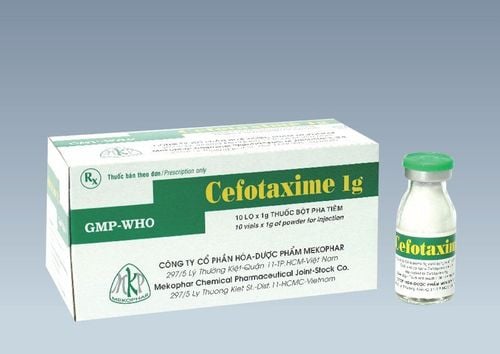This is an automatically translated article.
Daytrix contains ceftriaxone, a broad-spectrum 3rd generation cephalosporin that is used as an infusion. The drug is indicated in cases of infections caused by susceptible organisms Ceftriaxone.1. Uses of the drug Daytrix
Daytrix medicine has the main ingredient Ceftriaxone with a strength of 1g. Ceftriaxone is a broad-spectrum 3rd generation cephalosporin that is administered as an injection. The bactericidal mechanism of the drug is due to inhibition of bacterial cell wall synthesis. Ceftriaxone is stable to most beta-lactamases (penicillinase and cephalosporinase) of Gram-negative and Gram-positive bacteria. Daytrix is indicated in severe infections caused by microorganisms sensitive to ceftriaxone including meningitis, Lyme disease, urinary tract infections, pneumonia, gonorrhea, syphilis, typhoid, bacteremia, musculoskeletal and skin infections. In particular, the drug is used in the prevention of surgical infections.
2. Contraindications of the drug Daytrix
Daytrix is contraindicated in the following cases:
Hypersensitivity to Ceftriaxone or any component of the formulation Patients with a history of anaphylactic reactions to penicillins Infants with increased bilirubin, especially those premature birth because ceftriaxone has been reported to displace bilirubin from albumin-binding sites Concomitant use of intravenous calcium-containing solutions/products in neonates (≤28 days of age)
3. Dosage of the drug Daytrix
Adult patients and children over 12 years: The recommended dose is 2g/day. Ceftriaxone is administered once a day or twice a day. In most cases of mild or moderate infections, the dose can be increased to 4 g.
Infants: Daily dose is 20-50mg/kg body weight, single dose. Since the child's enzyme system is not yet complete, the dose should not exceed 50mg/kg body weight.
Children (3 weeks to 12 years): Daily dose varies from 20-80mg/kg body weight With doses greater than or equal to 50mg/kg should be administered intravenously over at least 30 minutes. Children weighing more than 50kg can take the same dose as adults.
Prevention of surgical infections: For the prevention of postoperative infections, a single dose of 1g IM should be administered one hour prior to surgery
Elderly patients: No change from adult patient dose
The duration of treatment depends on the type of infection and the severity of the disease. As with other conventional antibiotic therapy, Daytrix should be continued for at least 48-72 hours, after the patient is symptom-free.
4. Side effects of the drug Daytrix
Patients using Daytrix may experience side effects including:
Frequency > 10%:
Local: Allergy at injection site, pain, phlebitis Frequency 1-10%:
Heart pulse: Flushing Dermatology: Itching, skin rash Gastrointestinal: Clostridium difficile colitis, diarrhea, gastrointestinal disturbances, nausea, vomiting Genitourinary system: Blood in urine, vaginitis Hematology: Anemia , eosinophilia, hemolytic anemia, leukopenia, prolongation of prothrombin time, thrombocytosis Liver: Increase in serum ALT, increase in alkaline phosphatase, increase in serum bilirubin Infection: Candida infection Nervous system: Chills, headache Kidney: Increased urea, increased serum creatinine Frequency <1%:
Cardiovascular: Palpitations Endocrine and metabolic: Urinary tract Gastrointestinal: Abdominal pain, biliary stones, dyspepsia, flatulence , pancreatitis Hematology: Agranulocytosis, basocytosis, decreased prothrombin time, lymphocytosis Liver: Jaundice Hypersensitivity: Anaphylaxis, serum sickness Nervous system: Convulsions
5. Notes when using Daytrix
Before initiating treatment with Ceftriaxone, a thorough investigation of the patient's history of allergy to cephalosporin antibiotics, penicillins or other drugs should be made.
In case of renal failure, the dose must be carefully adjusted according to the patient's renal function. For patients with significant impairment of both hepatic and renal function, the dose of Ceftriaxone should not exceed 2g/day and these patients should be closely monitored for plasma concentrations
An increase in INR may occur. , especially in patients with undernutrition, prolonged therapy, or liver or kidney disease. Monitor INR during therapy if patients have impaired vitamin K synthesis or low stores.
Superinfection: Prolonged use of Daytrix may lead to fungal or bacterial superinfection.
Neonates: Extreme caution should be exercised when Daytrix is administered to neonates due to the risk of hyperbilirubinemia, especially in premature infants. Note contraindicated in neonates with hyperbilirubinemia.
Pregnant women: Ceftriaxone is recommended for use in pregnant patients for the treatment of gonococcal infections, Lyme disease and may be used in certain circumstances before vaginal delivery in these patients. at high risk for endocarditis. Note Ceftriaxone should not be used as a surrogate agent in pregnant patients allergic to penicillin for the treatment of maternal syphilis or the prevention of congenital syphilis.
Lactation: Ceftriaxone is considered safe in nursing women when used at the normally recommended doses. Note, the drug is found in breast milk and can cause changes in the gut microbiota in the baby. Therefore, it is advisable to monitor for signs of digestive disorders in children.
6. Daytrix drug interactions
Here are some important interactions, to be aware of when using Daytrix:
Concomitant use with other cephalosporin antibiotics or with diuretics such as furosemide can cause kidney failure. Synergy between Ceftriaxone and Aminoglycosides has been demonstrated experimentally with Gr(-) bacilli and this is especially important in life-threatening infections such as P aeruginosa. However, because these two drugs are incompatible, they should not be mixed when injecting. The nephrotoxic potential of the drug may be enhanced by gentamicin, colistin. Probenecid increases the plasma concentration of Daytrix due to a decrease in renal clearance. Cephalosporins may enhance the anticoagulant effect of vitamin K antagonists. Therefore, close monitoring is required when using these two drugs concurrently. Ceftriaxone binds calcium in Ringer's lactate solution and forms an insoluble precipitate. Ceftriaxone is therefore contraindicated in neonates (28 days of age and younger) who require or are expected to require intravenous calcium-containing solutions. The article has provided an overview of the drug Daytrix. This is a prescription antibiotic used by injection, so patients absolutely should not self-medicate but need to go to medical facilities for appropriate examination and indications.
Please dial HOTLINE for more information or register for an appointment HERE. Download MyVinmec app to make appointments faster and to manage your bookings easily.













